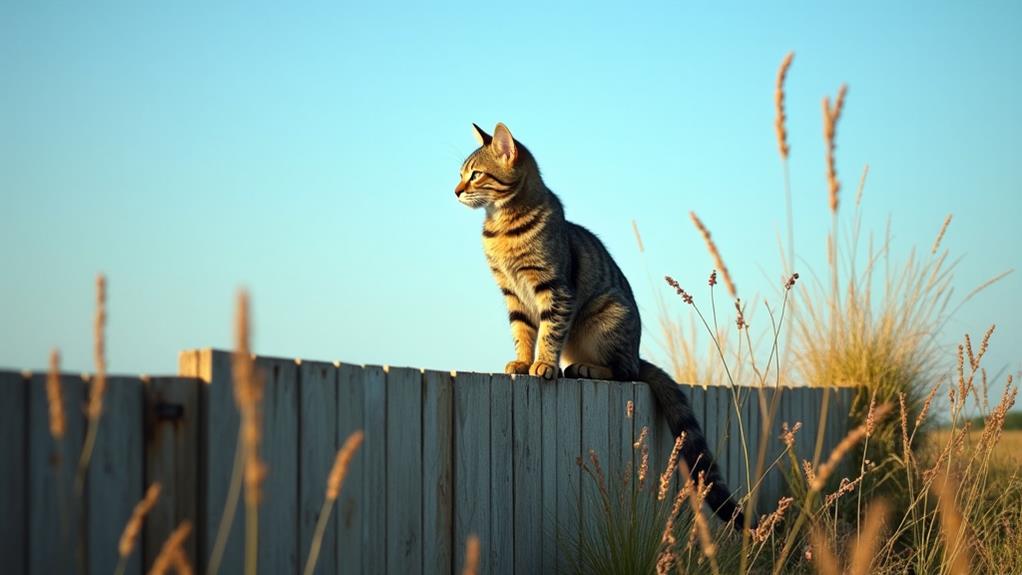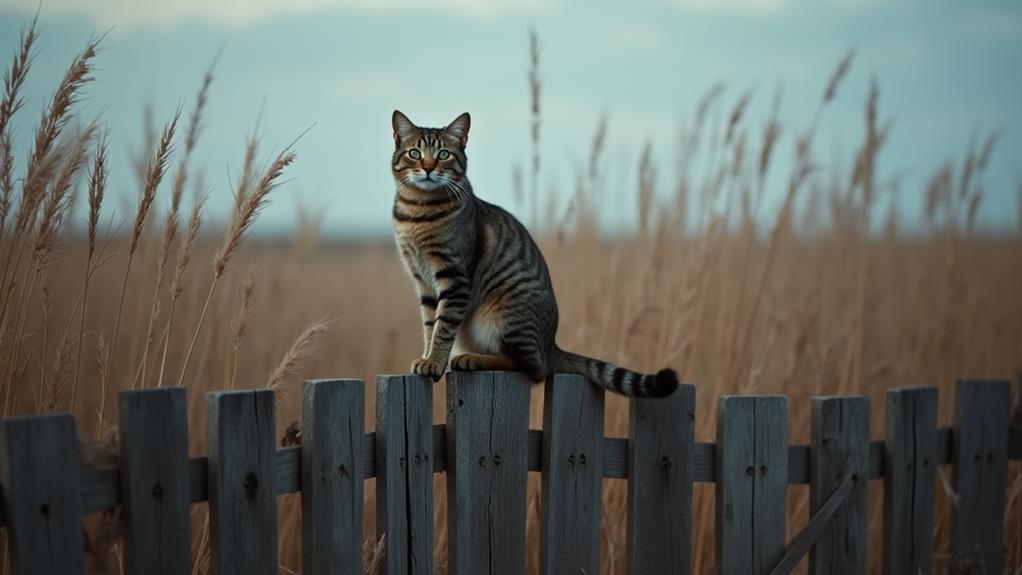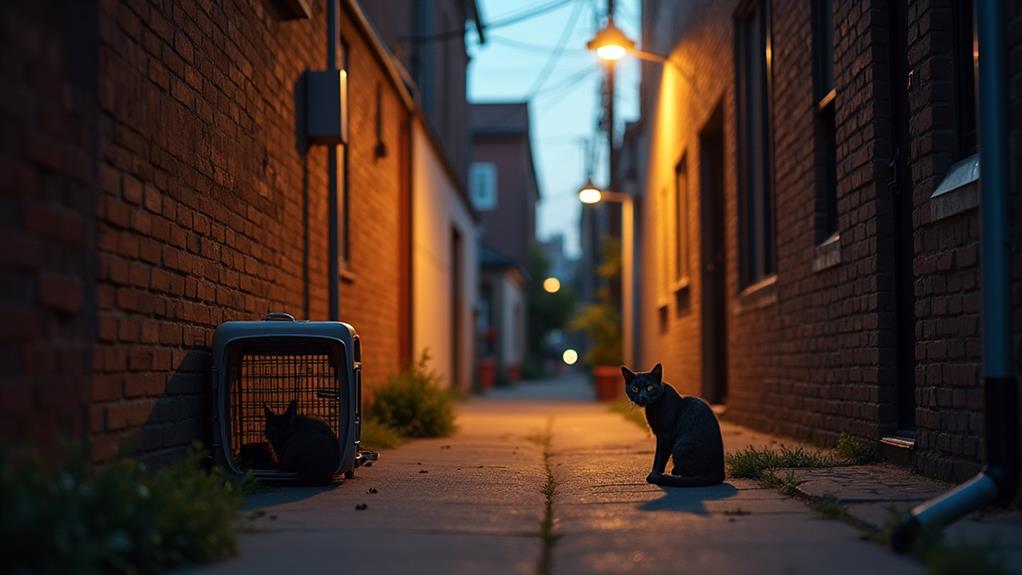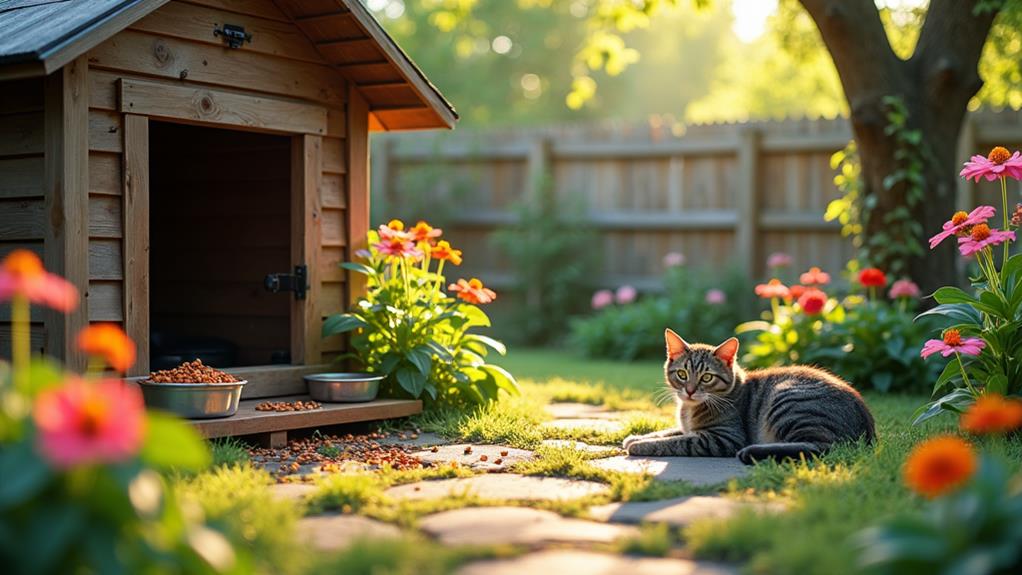What Is the Average Lifespan of a Feral Cat?

You might be surprised to learn that feral cats usually live between 2 to 5 years. Their challenging outdoor life is full of risks like predation, traffic, and disease. However, if they're part of managed colonies with human support from TNR programs, they can enjoy a longer life, even reaching 7 to 10 years. Providing consistent food, water, and shelter also plays an essential role in improving their lifespan. Understanding the harsh realities they face helps explain why feral cats wouldn't typically live as long as indoor cats, but there's more to it if you're curious about their survival strategies.
Defining Feral Cats
In relation to understanding feral cats, it is vital to recognize that these are domestic cats that have adapted to life in the wild. Unlike stray cats, feral cats are typically born outside and have minimal human interaction. They avoid human contact and often exhibit fearful behavior. You might find them forming colonies, which provide a social structure important for their survival in harsh living conditions. These conditions include limited access to food and water, exposure to the elements, and threats from predators or vehicles.
Feral cats reproduce rapidly. A single female can produce 5 litters annually, resulting in 20-30 new feral cats each year. This rapid reproduction contributes to an estimated 60-100 million feral cats in the U.S. However, these cats face considerable challenges. Without regular veterinary care, their health suffers, contributing to an average lifespan notably shorter than that of domestic cats. Typically, feral cats live only 2 to 5 years, compared to the longer lives of domestic cats who receive proper care and shelter. Understanding these differences is vital for grasping the challenges feral cats face in their daily lives.
Factors Affecting Longevity
Several key factors heavily influence the longevity of feral cats. Their average lifespan typically ranges from 2 to 5 years, primarily due to harsh living conditions and the absence of medical care. However, with access to consistent food and water, and the support of community caretakers, feral cats can live much longer. Well-cared-for colonies sometimes see lifespans extending to 7-10 years or even more.
Spaying or neutering plays a vital role in extending a feral cat's lifespan. These procedures reduce health risks and mellow aggressive behaviors, leading to fewer fights and injuries. Moreover, they help control population, lessening the stress on available resources like food and water.
Environmental threats, such as predation, traffic, and harsh weather, greatly increase mortality rates among feral cats. Cold winters and hot summers can be particularly brutal if adequate shelter isn't available. Diseases, including upper respiratory infections and parasites, pose another major threat, emphasizing the need for regular health monitoring.
Understanding these factors can help you improve a feral cat's quality of life. By focusing on food and water availability, spaying or neutering, and protection from environmental hazards, you can make a considerable difference in their longevity.
Typical Life Expectancy

Understanding the typical life expectancy of feral cats requires a look at their challenging environments. Generally, feral cats have an average lifespan of just 2 to 5 years. This is largely due to harsh living conditions and lack of medical care. Many feral kittens struggle to survive past their initial year, with nearly half succumbing to disease and exposure. These cats face threats from predators, traffic, and fluctuating weather, making life a constant battle.
However, feral cats in managed colonies can often enjoy longer lives, sometimes reaching 7 to 10 years or more. Managed colonies benefit from caretakers who provide food, shelter, and essential veterinary care. Programs like Trap-Neuter-Return (TNR) are significant in this situation. TNR helps control the feral cat population, reduces stress and aggressive behavior, and improves general health. Cats in these programs are less likely to suffer from injuries or diseases related to mating.
Indoor vs. Outdoor Comparisons
When comparing the lifespans of indoor and outdoor cats, it's clear that indoor cats live markedly longer. Typically, indoor cats enjoy a lifespan of 10 to 15 years, thanks to their sheltered environments and regular veterinary care. They face fewer risks from hazards, diseases, and predators. In contrast, feral cats, who make up a notable portion of outdoor cat life, often only live between 2 to 5 years. The lifespan of a feral cat is considerably shorter due to exposure to harsh weather conditions, diseases, starvation, and human cruelty.
For feral cat populations, survival is a daily challenge. They're often deprived of consistent food sources and medical attention, which indoor cats readily receive. While indoor/outdoor cats have a lifespan that falls somewhere in between, they still face some outdoor risks. However, their access to shelter and food contributes to a longer life compared to feral cats.
Environmental conditions and community support can slightly impact the lifespan of feral cats, but they generally can't reach the longevity indoor cats enjoy. The stark difference in lifespan highlights the challenges of outdoor cat life and underscores the benefits of keeping cats indoors.
The Role of TNR Programs

Feral cats face significant challenges in their shortened lifespans, but there's a proactive approach that can make a difference: Trap-Neuter-Return (TNR) programs. These initiatives focus on humanely trapping feral cats, spaying or neutering them, vaccinating, and then returning them to their original territory. By doing so, TNR programs stabilize feral cat populations, preventing unaltered cats from reproducing and contributing to healthier colony dynamics.
When you involve feral cats in TNR programs, you'll notice a significant increase in their lifespan. Cats that undergo TNR can live 7-10 years or even longer, compared to the 2-5 years typical for unsterilized feral cats. This increase in lifespan is partly due to the ongoing role of community caretakers who provide food, shelter, and medical care, enhancing the quality of life for these cats.
Additionally, TNR programs lead to reduced nuisance behaviors and lower disease transmission rates, positively impacting local ecosystems. By participating in or supporting TNR programs, you can help create a healthier environment for feral cats, improve their quality of life, and contribute to the general wellbeing of animal populations in your community.
Survival Challenges
Survival challenges for feral cats are daunting and multifaceted. As you observe these resilient creatures, you'll realize their life is a constant battle against exposure to harsh weather and other relentless threats. Nearly half of feral kittens don't make it past their initial year. Diseases and the severe conditions they face daily contribute greatly to this high mortality rate. Unlike indoor cats, whose lifespans often exceed a decade, the average lifespan of feral cats is a mere 2 to 5 years.
One of the primary threats to their survival is the lack of basic necessities like shelter, food, and medical care. Feral cats often fall victim to starvation and predation, with other animals viewing them as both competitors and prey. Human cruelty adds another layer of risk, as they sometimes face intentional harm. Environmental hazards, including busy traffic and extreme weather conditions, further endanger their limited life span.
Moreover, untreated diseases and injuries are rampant among feral populations. Without access to veterinary care, even minor ailments can become life-threatening, leading to early deaths. These elements all combine to paint a challenging picture of survival for feral cats, highlighting their struggle for life every day.
Human Impact and Support

Human intervention plays a vital role in enhancing the lives of feral cats. By engaging in efforts like Trap-Neuter-Return (TNR) programs, you're not only controlling the population but also markedly increasing their lifespan. Managed colonies benefit from this approach, with feral cats living 7-10 years or longer compared to the typical 2-5 years for unsterilized cats. Community support is fundamental—by providing nutritionally balanced meals and fresh water, alongside insulated shelters, you can drastically improve their health and survival rates.
Consider these impactful actions:
- Participate in local TNR programs to help manage feral cat populations humanely.
- Offer consistent food and water to guarantee they maintain a nutritionally balanced diet.
- Build or donate insulated shelters to protect them from harsh weather conditions.
- Monitor health issues and seek veterinary care through local organizations.
- Educate others about humane treatment and the importance of community involvement.
Ultimately, the involvement of compassionate individuals like you can make a considerable difference. By addressing health issues and guaranteeing these cats are well cared for, you contribute to their wellbeing and longevity, fostering a harmonious coexistence in your community.
Regional Variations in Lifespan
Depending on the region, the lifespan of feral cats can vary considerably due to factors like climate, resource availability, and community support. In urban areas, feral cats often face harsher conditions, which can result in shorter lifespans. The dense population and limited space make it difficult for these cats to find enough food and shelter. In contrast, rural settings offer more accessible resources, allowing feral cats to potentially live longer. The open spaces and lower human population density in rural areas contribute to a more suitable environment for these cats.
Climate also plays a significant role in determining the lifespan of feral cats. Those living in warmer climates generally have a slight advantage, as they avoid the harsh winter conditions that can severely impact their survival. Furthermore, managed feral cat colonies, particularly those involved in Trap-Neuter-Return (TNR) programs, can greatly improve the lifespan of these animals. With regular feeding and healthcare, cats in these colonies can live up to 7-10 years. Regional access to veterinary care and community support is essential, as areas with active involvement in feral cat care tend to see healthier, longer-lived feline populations.
Enhancing Feral Cat Lifespan

To improve the lifespan of feral cats, it is vital to implement thorough care strategies that address their primary needs. By taking proactive steps, you can help these cats live longer, healthier lives. Start by participating in Trap-Neuter-Return (TNR) programs. TNR reduces overpopulation and boosts the health of feral cats, as fewer kittens mean more resources for existing colonies. Consistent access to food and clean water is fundamental; it supports their health and helps them endure harsh weather conditions.
Shelter is another important factor. Providing protection from extreme weather with insulated structures filled with straw can greatly improve their well-being. Regular health monitoring and veterinary care, including vaccinations, are vital. By catching health issues early, you can contribute to a longer lifespan for these cats.
Here are some steps you can take:
- Participate in TNR programs to control the population and boost health.
- Ensure consistent access to food and clean water.
- Construct or provide shelters to protect against extreme weather.
- Conduct regular health monitoring and provide necessary veterinary care.
- Engage the community to support feral cat programs and care initiatives.
These efforts can make a notable difference in improving the lifespan of feral cats.




